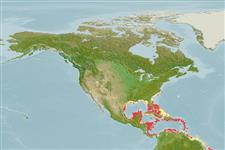Common names from other countries
>
Anguilliformes (Eels and morays) >
Chlopsidae (False morays)
Etymology: Kaupichthys: Because of Johann Jakob Kaup, 1827; author of "Zoologische Monographien", ichthyologist + Greek, ichthys = fish.
Environment: milieu / climate zone / depth range / distribution range
экология
морской ассоциированный с рифами. Tropical
Western Atlantic: Texas, USA and the Bahamas to the Antilles (Ref. 26340) and northern South America. Northwestern Gulf of Mexico to Caribbean (Ref. 26938).
Size / Вес / Возраст
Maturity: Lm ? range ? - ? cm
Max length : 16.0 cm TL самец/пол неопределен; (Ref. 7251)
Краткое описание
морфология | морфометрия
Moderately slender eel, with pale band around head behind eye (Ref. 26938).
A benthic and solitary species (Ref. 26340) occurring in and around coral reefs. Sometimes lives in tubular sponges, and suggested that this is its primary habitat (Ref. 26938).
Life cycle and mating behavior
половая зрелость | размножение | нерест | икра | Fecundity | личинки
Robins, C.R. and G.C. Ray, 1986. A field guide to Atlantic coast fishes of North America. Houghton Mifflin Company, Boston, U.S.A. 354 p. (Ref. 7251)
Статус Красного Списка МСОП (Ref. 130435)
CITES (Ref. 128078)
Not Evaluated
Угроза для людей
Harmless
Использование человеком
дополнительная информация
Возраст/РазмерыростЗависимость между длиной и массой телаЗависимость между длинамиРазмерный составморфометрияморфологияличинкидинамика численности личинокпополнениечисленность
ссылкиаквакультура (рыбоводство)особенности рыбоводствастепень растяжениягенетикаElectrophoresesнаследуемостьболезниобработкаMass conversion
соавторыизображенияStamps, Coins Misc.звукиCiguateraскоростьтип плаванияжаберная областьOtolithsмозгзрение
инструменты
Специальные отчеты
Скачать в формате XML
ресурсы в Интернет
Estimates based on models
Preferred temperature (Ref.
115969): 25.5 - 28.2, mean 27.4 (based on 635 cells).
Phylogenetic diversity index (Ref.
82804): PD
50 = 0.5156 [Uniqueness, from 0.5 = low to 2.0 = high].
Bayesian length-weight: a=0.00102 (0.00046 - 0.00225), b=3.06 (2.88 - 3.24), in cm Total Length, based on all LWR estimates for this body shape (Ref.
93245).
Trophic level (Ref.
69278): 3.7 ±0.6 se; based on size and trophs of closest relatives
Fishing Vulnerability (Ref.
59153): Low vulnerability (10 of 100).
